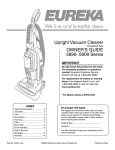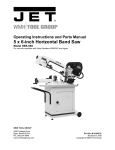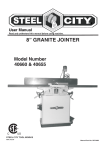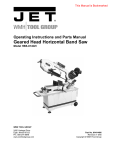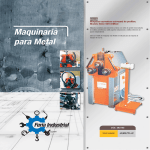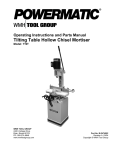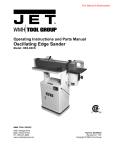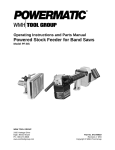Download Wilton 41002 Operating instructions
Transcript
Operating Instructions and Parts Manual Belt and Disc Sander Model 41002 WMH TOOL GROUP 2420 Vantage Drive Elgin, Illinois 60123 Ph.: 800-274-6848 www.wmhtoolgroup.com Part No. M-41002 Revision A 10/05 Copyright © WMH Tool Group This manual has been prepared for the owner and operators of a Wilton 41002 Belt/Disc Sander. Its purpose, aside from machine operation, is to promote safety using accepted operating and maintenance procedures. To obtain maximum life and efficiency from your sander and to aid in using it safely, please read this manual thoroughly and follow the instructions carefully. Warranty and Service WMH Tool Group warrants every product it sells. If one of our tools needs service or repair, one of our Authorized Service Center located throughout the United States can provide quick service or information. In most cases, a WMH Tool Group Service Center can assist in authorizing repair work, obtaining parts, or perform routine or major maintenance repair on your Wilton product. For the name of an Authorized Service Center in your area, please call 1-800-274-6848, or visit our web site at www.wmhtoolgroup.com More Information Remember, WMH Tool Group is consistently adding new products to the line. For complete, up-to-date product information, check with your local WMH Tool Group distributor, or visit our web site at www.wmhtoolgroup.com WMH Tool Group Warranty WMH Tool Group makes every effort to assure that its products meet high quality and durability standards and warrants to the original retail consumer/purchaser of our products that each product be free from defects in materials and workmanship as follows: 1 YEAR LIMITED WARRANTY ON ALL PRODUCTS UNLESS SPECIFIED OTHERWISE. This Warranty does not apply to defects due directly or indirectly to misuse, abuse, negligence or accidents, normal wear-and-tear, repair or alterations outside our facilities, or to a lack of maintenance. WMH TOOL GROUP LIMITS ALL IMPLIED WARRANTIES TO THE PERIOD SPECIFIED ABOVE, BEGINNING FROM THE DATE THE PRODUCT WAS PURCHASED AT RETAIL. EXCEPT AS STATED HEREIN, ANY IMPLIED WARRANTIES OR MERCHANTABILITY AND FITNESS ARE EXCLUDED. SOME STATES DO NOT ALLOW LIMITATIONS ON HOW LONG THE IMPLIED WARRANTY LASTS, SO THE ABOVE LIMITATION MAY NOT APPLY TO YOU. IN NO EVENT SHALL WMH TOOL GROUP BE LIABLE FOR DEATH, INJURIES TO PERSONS OR PROPERTY, OR FOR INCIDENTAL, CONTINGENT, SPECIAL, OR CONSEQUENTIAL DAMAGES ARISING FROM THE USE OF OUR PRODUCTS. SOME STATES DO NOT ALLOW THE EXCLUSION OR LIMITATION OF INCIDENTAL OR CONSEQUENTIAL DAMAGES, SO THE ABOVE LIMITATION OR EXCLUSION MAY NOT APPLY TO YOU. To take advantage of this warranty, the product or part must be returned for examination, postage prepaid, to an Authorized Service Center designated by our office. Proof of purchase date and an explanation of the complaint must accompany the merchandise. If our inspection discloses a defect, we will either repair or replace the product at our discretion, or refund the purchase price if we cannot readily and quickly provide a repair or replacement. We will return the repaired product or replacement at WMH Tool Group’s expense, but if it is determined there is no defect, or that the defect resulted from causes not within the scope of WMH Tool Group’s warranty, then the user must bear the cost of storing and returning the product. This warranty gives you specific legal rights; you may also have other rights, which vary from state to state. WMH Tool Group sells through distributors only. Members of the WMH Tool Group reserve the right to effect at any time, without prior notice, alterations to parts, fittings and accessory equipment, which they may deem necessary for any reason whatsoever. 2 Table of Contents Warranty and Service ..............................................................................................................................2 Table of Contents ....................................................................................................................................3 Warning...................................................................................................................................................4 Introduction..............................................................................................................................................6 Specifications ..........................................................................................................................................6 Features and Terminology .......................................................................................................................7 Unpacking ...............................................................................................................................................8 Contents of the Shipping Container ......................................................................................................8 Assembly.................................................................................................................................................9 Installing Belt Table ..............................................................................................................................9 Installing Dust Chute ............................................................................................................................9 Installing Disc Table ...........................................................................................................................10 Installing Miter Gauge.........................................................................................................................10 Installing Tension Handle ...................................................................................................................10 Grounding Instructions...........................................................................................................................11 115 Volt Operation .............................................................................................................................11 Extension Cords.................................................................................................................................12 Adjustments...........................................................................................................................................12 Tilting the Belt Table...........................................................................................................................12 Tilting the Disc Table..........................................................................................................................12 Use of the Miter Gauge ......................................................................................................................13 Belt Platen..........................................................................................................................................13 Abrasive Belt Replacement ................................................................................................................14 Tracking the Abrasive Belt..................................................................................................................14 Abrasive Disc Replacement................................................................................................................15 Aluminum Disc Removal ....................................................................................................................15 Operation...............................................................................................................................................16 Starting and Stopping the Sander.......................................................................................................16 Belt and Disc Movement.....................................................................................................................16 Typical Operations .............................................................................................................................16 Maintenance..........................................................................................................................................18 Replacement Parts ................................................................................................................................18 Troubleshooting.....................................................................................................................................19 2x42x8 Belt and Disc Sander..............................................................................................................20 Parts List for 2x42x8 Belt and Disc Sander .........................................................................................21 3 Warning 1. Read and understand the entire owners manual before attempting assembly or operation. 2. Read and understand the warnings posted on the machine and in this manual. Failure to comply with all of these warnings may cause serious injury. 3. Replace the warning labels if they become obscured or removed. 4. This sander is designed and intended for use by properly trained and experienced personnel only. If you are not familiar with the proper and safe operation of a sander, do not use until proper training and knowledge have been obtained. 5. Do not use this sander for other than its intended use. If used for other purposes, WMH Tool Group disclaims any real or implied warranty and holds itself harmless from any injury that may result from that use. 6. Always wear approved safety glasses/face shields while using this sander. Everyday eyeglasses only have impact resistant lenses; they are not safety glasses. 7. Before operating this sander, remove tie, rings, watches and other jewelry, and roll sleeves up past the elbows. Remove all loose clothing and confine long hair. Non-slip footwear or anti-skid floor strips are recommended. Do not wear gloves. 8. Wear ear protectors (plugs or muffs) during extended periods of operation. 9. Some dust created by power sanding, sawing, grinding, drilling and other construction activities contain chemicals known to the State of California to cause cancer, birth defects or other reproductive harm. Some examples of these chemicals are: • Lead from lead based paint. • • Crystalline silica from bricks, cement and other masonry products. Arsenic and chromium from chemically treated lumber. Your risk of exposure varies, depending on how often you do this type of work. To reduce your exposure to these chemicals, work in a well-ventilated area and work with approved safety equipment, such as face or dust masks that are specifically designed to filter out microscopic particles. 10. Do not operate this machine while tired or under the influence of drugs, alcohol or any medication. 11. Make certain the switch is in the OFF position before connecting the machine to the power supply. 12. Make certain the machine is properly grounded. 13. Make all machine adjustments or maintenance with the machine unplugged from the power source. 14. Remove adjusting keys and wrenches. Form a habit of checking to see that keys and adjusting wrenches are removed from the machine before turning it on. 15. Keep safety guards in place at all times when the machine is in use. If removed for maintenance purposes, use extreme caution and replace the guards immediately. 16. If there is a tendency for the machine to tip over or move during operation, such as when sanding long or heavy boards, the machine must be securely fastened to a supporting surface. 17. Check damaged parts. Before further use of the machine, a guard or other part that is damaged should be carefully checked to determine that it will operate properly and perform its intended function. Check for alignment of moving parts, binding of moving parts, breakage of parts, mounting and any other conditions that may affect its operation. A guard or other part that is damaged should be properly repaired or replaced. 18. Provide for adequate space surrounding work area and non-glare, overhead lighting. 19. Keep the floor around the machine clean and free of scrap material, oil and grease. 20. Keep visitors a safe distance from the work area. Keep children away. 4 blahblahblah 21. Make your workshop child proof with padlocks, master switches or by removing starter keys. 22. Give your work undivided attention. Looking around, carrying on a conversation and “horse-play” are careless acts that can result in serious injury. 23. Maintain a balanced stance at all times so that you do not fall or lean against the abrasives or other moving parts. Do not overreach or use excessive force to perform any machine operation. 24. Use the right tool at the correct speed and feed rate. Do not force a tool or attachment to do a job for which it was not designed. The right tool will do the job better and safer. 25. Make sure the abrasive belt is running in the proper direction. When disc sanding, place the workpiece against the downward rotating part of the abrasive disc. 26. This machine can be used for sanding wood or metal products. However, combining wood dust and metal filings can create a fire hazard. Make sure your dust collector is free of wood dust deposits before processing metal products. 27. Use recommended accessories; improper accessories may be hazardous. 28. Maintain tools with care. Follow instructions for lubricating the machine and changing accessories. 29. Abrasive discs must be stored in a controlled environment. Relative humidity should be 35% to 50% and the temperature should be between 60° and 80° Fahrenheit. Failure to do this could cause premature disc failure. 30. Examine the face of the abrasive disc or belt carefully. Excessive sanding that wears down to the backing material can tear the disc/belt. Never use an abrasive which shows backing, nicks or cuts on the surface or edge, or damage due to creasing or poor handling. 31. Turn off the machine before cleaning. Use a brush or compressed air to remove chips or debris — do not use your hands. 32. Never leave the machine running unattended. Turn the power off and do not leave the machine until it comes to a complete stop. 33. Do not use the sander in wet or damp locations. 34. Remove loose items and unnecessary work pieces from the area before starting the machine. Familiarize yourself with the following safety notices used in this manual: This means that if precautions are not heeded, it may result in minor injury and/or possible machine damage. This means that if precautions are not heeded, it may result in serious injury or possibly even death. - - SAVE THESE INSTRUCTIONS - 5 Introduction This manual is provided by WMH Tool Group covering the safe operation and maintenance procedures for a Wilton 2x42x8 Belt and Disc Sander. This manual contains instructions on installation, safety precautions, general operating procedures, maintenance instructions and parts breakdown. This machine has been designed and constructed to provide years of trouble free operation if used in accordance with instructions set forth in this manual. If there are any questions or comments, please contact either your local supplier or WMH Tool Group. WMH Tool Group can also be reached at our web site: www.wmhtoolgroup.com. Specifications Stock Number.................................................................................................................................. 41002 Belt Size (in.)(LxW).......................................................................................................................... 42 x 2 Disc Size (in.) ........................................................................................................................... 8 diameter Motor............................................................................................................................. 3/4HP, 1Ph, 115V Belt Table Size (in.)(LxW) ................................................................................................................ 10 x 6 Disc Table Size (in.)(LxW) ................................................................................................... 10-3/4 x 7-1/2 Table Tilt (deg.) .............................................................................................................................. 0 to 45 Dust Chutes (in.)...................................................................................................... two @ 1-1/2 diameter Overall Size (in.)(WxDxH) ........................................................................................... 20-1/2 x 22-3/4 x 20 Approximate Net Weight (lbs.) ............................................................................................................... 58 Approximate Shipping Weight (lbs.) ....................................................................................................... 64 The above specifications were current at the time this manual was published, but because of our policy of continuous improvement, WMH Tool Group reserves the right to change specifications at any time and without prior notice, without incurring obligations. 6 Features and Terminology 7 Contents of the Shipping Container Unpacking 1 1 1 1 1 6 3 3 1 1 3 1 1 Open shipping container and check for shipping damage. Report any damage immediately to your distributor and shipping agent. Do not discard any shipping material until the sander is assembled and running properly. Compare the contents of your container with the following parts list to make sure all parts are intact. Missing parts, if any, should be reported to your distributor. Read the instruction manual thoroughly for assembly, maintenance and safety instructions. Belt and Disc Sander Belt Table Disc Table with trunnions Miter Gauge Dust Chute Phillips Pan Hd. Machine Screws, 3/16x3/8” Handles Flat Washers, 3/8” Tension Handle Hex Nut, 1/4” Hex Wrenches, 3, 4 and 6mm Owner's Manual Warranty Card Read and understand the entire contents of this manual before attempting set-up or operation! Failure to comply may cause serious injury. 8 Assembly Tools needed for assembly: • 10mm open-end wrench • Cross-point (Phillips) screwdriver • Combination square, or similar measuring device. angle Sander must be unplugged from power source during assembly. Remove the protective coating from the surfaces of the sander and from any loose parts. This coating may be removed with a soft cloth moistened with kerosene (do not use acetone, gasoline or lacquer thinner for this purpose). After cleaning, cover the table surfaces with a good quality paste wax. Leave enough space around the sander for long workpieces and for general maintenance. If needed, the sander can be bolted to a table or workbench using the holes in the base. If the sander has a tendency to walk or slide during operation, it must be bolted to a supporting surface. Installing Belt Table 1. Unscrew the stud. See Figure 1. 2. Position the bracket of the belt table over the holes in the casting as shown, and re-install the stud into its hole. 3. Place a flat washer onto a handle, and insert the handle through the table bracket and into the hole. Screw the handle all the way into the hole. NOTE: The handle is spring loaded; screw the handle in by rotating clockwise, then pull outward on the handle. Rotate the handle back to position, then release it, making sure it seats itself upon the pin. Continue the process until the handle is tightened in the hole. Figure 1 Installing Dust Chute The sander has two 1-1/2” diameter dust chutes. The dust chute for the belt is located on the belt cover. The dust chute for the disc should be installed as shown in Figure 2, using the six (6) pan head machine screws that are provided. The dust chutes can be connected to a vacuum system to collect dust particles. Figure 2 9 Installing Disc Table 1. Position the disc table at an angle, as shown in Figure 3, and slide the table on so that the trunnion slots fit over the raised tracks on the disc guard. 2. Install a flat washer onto each of the two remaining handles. Insert the handle into the holes through the left and right trunnions. See Figure 4. 3. The gap between the sanding disc and the disc table should be a maximum of 1/16”. If it is larger than this, loosen the two socket head cap screws on the disc guard (one is shown in Figure 4) and slide the disc guard to achieve this gap measurement. Figure 3 4. When finished, tighten the two socket head cap screws securely. Figure 4 Installing Miter Gauge Insert the miter gauge bar into one end of the miter slot in the disc table. See Figure 5. The miter gauge can be used in either direction in the slot to achieve the most effective positioning of the workpiece against the abrasive disc. Figure 5 Installing Tension Handle 1. Place the 1/4” hex nut onto the threads of the tension handle. 2. Screw the tension handle into the hole on the hub, then tighten the hex nut against the hub. See Figure 6. Figure 6 10 Grounding Instructions This machine must be grounded while in use to protect the operator from electric shock. In the event of a malfunction or breakdown, grounding provides a path of least resistance for electric current to reduce the risk of electric shock. This tool is equipped with an electric cord having an equipment-grounding conductor and a grounding plug. The plug must be inserted into a matching receptacle that is properly installed and grounded in accordance with all local codes and ordinances. Do not modify the plug provided. If it will not fit the outlet, have the proper outlet installed by a qualified electrician. Improper connection of the equipmentgrounding conductor can result in a risk of electric shock. The conductor, with insulation having an outer surface that is green with or without yellow stripes, is the equipmentgrounding conductor. If repair or replacement of the electric cord or plug is necessary, do not connect the equipment-grounding conductor to a live terminal. Check with a qualified electrician or service personnel if the grounding instructions are not completely understood, or if in doubt as to whether the tool is properly grounded. Use only three wire extension cords that have three-prong grounding plugs and three-pole receptacles that accept the tool’s plug. 115 Volt Operation As received from the factory, your sander is ready to run at 115 volt operation. This sander is intended for use on a circuit that has an outlet and a plug that looks like the one illustrated in Figure 7. A temporary adapter, like the adapter in Figure 8, may be used to connect this plug to a twopole receptacle, as shown in Figure 8, if a properly grounded outlet is not available. The temporary adapter should only be used until a properly grounded outlet can be installed by a qualified electrician. This adapter is not applicable in Canada. The green colored rigid ear, lug, or tab, extending from the adapter, must be connected to a permanent ground such as a properly grounded outlet box, as shown in Figure 8. Figure 7 Figure 8 11 Extension Cords Use proper extension cords. Make sure the cord rating is suitable for the amperage of the machine’s motor. An undersized cord will cause a drop in line voltage resulting in loss of power and overheating. Recommended Gauges (AWG) of Extension Cords Extension Cord Length * Use the chart in Figure 9 as a general guide in choosing the correct size cord. The smaller the gauge number, the heavier the cord. Adjustments Tilting the Belt Table The belt table tilts from zero (horizontal) down to 45°. 1. Loosen the handle and adjust the table into desired position. Amps 25 feet 50 feet 75 feet 100 feet 150 feet 200 feet <5 16 16 16 14 12 12 5 to 8 16 16 14 12 10 NR 8 to 12 14 14 12 10 NR NR 12 to 15 12 12 10 10 NR NR 15 to 20 10 10 10 NR NR NR 21 to 30 10 NR NR NR NR NR *based on limiting the line voltage drop to 5V at 150% of the rated amperes. NR: Not Recommended. Figure 9 2. Check the angle with a machinist’s protractor or similar measuring device that has the required angle. Figure 10 shows a square being used to confirm the zero, or horizontal, position. Place the square flat on the table and against the belt. Push against the belt until the square is against the platen. 3. Make any adjustments to the table angle as necessary until it is square with the belt. 4. Tighten the handle securely. To avoid trapping the workpiece or fingers between the table and abrasive belt, the table edge should be positioned a maximum of 1/16” from the abrasive belt. Figure 10 Tilting the Disc Table The disc table tilts from zero (horizontal) down to 45°. 1. Loosen both handles and adjust the table until the indicator lines up with the desired angle on the scale. It is a good idea to confirm this angle using your angle measuring device placed flat upon the table and against the abrasive disc. 2. Figure 11 shows a square being used to confirm the zero, or horizontal position of the disc table. 3. Make any necessary adjustments to the table angle. If the table is square with the disc but the angle indicator needs slight adjustment, loosen the screw on the indicator and shift the indicator as needed. Re-tighten the screw. Figure 11 12 4. Tighten both handles securely. To avoid trapping the workpiece or fingers between the table and abrasive disc, the table edge should be positioned a maximum of 1/16” from the abrasive disc. Use of the Miter Gauge The miter gauge is used to sand accurate angles on workpieces. When using the miter gauge on the horizontal table position, you can sand a single angle. By tilting the disc table and using the miter gauge in combination with the table tilted, it is possible to sand compound angles as well. The miter gauge rotates to 30° for bevel sanding. Loosen the knob and rotate the gauge body until the pointer lines up with the desired angle on the scale. Use a square to confirm that the miter gauge is set at 90° (perpendicular to the disc). See Figure 12. If slight adjustment is needed: Figure 12 1. Loosen the knob. 2. Adjust the miter gauge body until it is flush with the square, and the square is flush with the disc. 3. Tighten the knob. 4. Loosen the screw on the pointer and adjust the pointer until it aligns with 90° on the scale. 5. Tighten the screw on the pointer. Belt Platen The belt platen (Figure 13) is used to properly support the workpiece while sanding. The platen is constructed of heavy steel to provide adequate support. The platen should be adjusted so it is almost touching the back of the abrasive belt. Loosen the socket head cap screw and adjust the platen to the desired position. Tighten the screw to secure the platen. The platen can be removed for operations such as stripping, contour sanding, polishing or other special operations. To remove the platen, remove the socket head cap screw and washer. Figure 13 Be sure to re-install the platen to perform operations where support of the belt is required. 13 Abrasive Belt Replacement 1. Unplug the Sander from the power source. 2. Unscrew and remove the two knobs on the belt cover. 3. Remove the belt cover. 4. Rotate the tension handle (Figure 6) to loosen the belt, and remove the old belt from around the wheels. 5. Install the new belt around the wheels. IMPORTANT: Some sanding belts have a directional arrow printed on the inside of the belt. In these cases, the belt must be installed so the directional arrow is in the same direction that the machine is running. Refer to the rotation arrow on top of the belt cover. 6. Install the belt cover and the two knobs. 7. Start the sander and check the belt tracking before sanding operations (See “Tracking the Abrasive Belt”). Tracking the Abrasive Belt “Tracking” refers to the manner in which the abrasive belt is positioned on the wheels during operation. The belt should remain in vertical position without shifting to one side or the other of the wheel. If any shifting occurs, the belt needs to be tracked properly, as follows: 1. Disconnect sander from power source. 2. Remove the side cover, and make sure the belt is placed evenly over the center of the wheels. Loosen the tension and re-position the belt if necessary. Re-install the side cover. 3. Move the belt by rotating the disc with your hand (do not turn on the power yet). Observe the movement of the belt on the top wheel. Figure 14 4. If the belt slips to one side or the other, loosen the hex nut (Figure 14) with a 10mm open-end wrench. 5. Rotate the tracking screw (Figure 14) with a 5mm hex wrench. If the belt is sliding toward the right, rotate the screw clockwise. If the belt is sliding toward the left, rotate the screw counterclockwise. 6. Continue this procedure in small increments until the belt is tracking properly when moved by hand. 7. Re-connect the sander to power, and cycle the on/off switch quickly to double check the tracking. 14 8. Make further adjustments as needed. 9. Tighten the hex nut to secure the setting. Abrasive Disc Replacement 1. Unplug the sander from the power source. 2. Remove the dust cover and the disc table. To remove the disc table, remove the handles then tilt the disc table upward while pulling it away from the disc. 3. Peel off the old abrasive disc. 4. Thoroughly clean the aluminum disc surface using naptha or a similar non-flammable solvent that will dry film-free. 5. Pull the protective backing half-way off the new abrasive disc. 6. Carefully position the new abrasive disc so it is centered accurately on the aluminum disc. 7. When accurately centered, remove the rest of the protective backing and press the abrasive disc firmly against the aluminum disc so complete adhesive contact is made. 8. Re-install dust cover and table. 9. Reconnect sander to power source. Aluminum Disc Removal The aluminum disc can be easily removed if needed; for example, to facilitate cleaning the aluminum disc when replacing abrasive discs. 1. Unplug sander from the power source. 2. Remove the disc table and the dust chute. 3. Rotate the disc until the set screw is accessible through the opening behind the disc guard. See Figure 15. You may need to loosen the socket head cap screws (see Figure 4) on the guard and shift it forward in order to clear the set screw. 4. Loosen the set screw with a 3mm hex wrench, and pull the aluminum disc off the motor shaft. Figure 15 5. When re-mounting the aluminum disc, make sure the key is properly seated in the keyway on the motor shaft. Tighten the set screw firmly when the disc has been mounted. 15 Operation This sander is intended for dry sanding of metals. Do not use lubricants. Do not sand or polish magnesium; it may create a fire hazard. Also, do not sand very small or very thin workpieces that cannot be safely controlled. Starting and Stopping the Sander The on/off switch is located on the side of the motor housing. Move the switch upward to the ON position to start the sander. Move the switch downward to the OFF position to stop the sander. When the sander is not being used, the switch can be locked in OFF position to prevent unauthorized use. Pull out the locking tab and store in a safe place. See Figure 16. The switch will not operate with the locking tab removed. To use the sander, re-insert the locking tab. Belt and Disc Movement When the machine is turned on, the abrasive belt should be moving downward and the disc rotating clockwise. The motor is wired at the factory for correct rotation. Figure 16 The workpiece should not contact the disc or belt during start-up. Before sanding, always allow the motor to come up to operating speed, then observe the disc for wobble, runout, or any unbalanced condition. If the disc is not operating accurately and smoothly, stop the motor and make repairs before atempting any sanding operations. Always sand on the side of the abrasive disc that rotates downward. Sanding on the upward rotation side can cause the workpiece to catch and fly out of your hands. The table must be a maximum of 1/16” away from the abrasive disc or belt. Typical Operations When sanding a compound angle you should check the accuracy of your setup by sanding a piece of scrap material before doing any finish sanding on the actual workpiece. Figure 17 demonstrates a basic method of operation using the miter gauge and disc table: 1. Set the angle you wish to sand using the scale on the miter gauge. Figure 17 16 2. Tighten the miter gauge securely so the miter reference angle will not shift while you are sanding. 3. Place the workpiece against the miter reference surface and slide it along the miter reference surface and into the sanding disc. The following are just some of the many operations that can be performed with your Wilton Sander. • Sharpening a wood chisel on the sanding belt using a block of wood. Use the block of wood to support the chisel and provide clearance for the chisel handle. See Figure 18. Sand a bevel in the block of wood in order to position the block as close as possible to the sanding belt and clamp the block to the table. • A cold chisel can also be sharpened on the belt table with the table tilted. • Sanding aluminum on the disc unit with the table tilted and using the miter gauge as a guide. See Figure 19. • Sanding outside curves on the belt unit with the platen removed. See Figure 20. • Polishing using a felt belt (not provided) in place of the sanding belt. NOTE: Most polishing operations are performed with the platen removed. • Sanding in tight areas with the sanding belt. See Figure 21. Figure 18 Figure 19 Figure 20 Figure 21 17 Check all fasteners for tightness. Maintenance Inspect the power cord; if worn, cut, or damaged in any way, have it replaced immediately. Before performing any maintenance on the machine, disconnect it from the electrical supply by pulling out the plug or switching off the main switch. Failure to comply may cause serious injury. Inspect the abrasive belt and disc. If either is worn, replace it. Occasionally remove the belt cover and brush out any shavings or debris from around the wheels. Keep the table surfaces clean and free of rust. If rust appears on the tables, use 000 steel wool with a paste mixture of household ammonia and good commercial detergent (or use a commercial rust remover available from most hardware stores.) Lubrication All of the ball bearings are packed with grease and sealed at the factory. They require no further lubrication. A light coat of paste wax on the tables will help protect them from tarnish and reduce friction between table and workpiece. NOTE: Do not get paste wax on the abrasive belt or disc. Replacement Parts Replacement parts are listed on pages 20-22. To order parts or reach our service department, call 1-800274-6848 between 7:30 a.m. and 6:00 p.m. (CST), Monday through Friday. Having the Model Number and Serial Number of your machine available when you call will allow us to serve you quickly and accurately. 18 Troubleshooting Trouble Probable Cause Remedy Not connected to power source. Connect to power source. Branch circuit fuse is blown or the circuit breaker is tripped. Determine reason for blown fuse/ tripped breaker (such as short circuit or motor overload). Correct reason for fault. Replace fuse/ reset circuit breaker. Voltage is too low. Check power source for proper voltage. Switch is defective. Replace switch. Motor failure. Replace motor. Motor stalls easily. Low voltage. Check power source for proper voltage and correct if necessary. Abrasive disc separates from aluminum disc. Improper bond. Clean residual adhesive from aluminum disc, and re-apply adhesive-backed abrasive disc. Belt not centered on wheels. Readjust tracking. See page 14. Belt stretched unevenly. Replace abrasive belt. Belt is jointed improperly. Check the belt for an irregular seam or shape. Replace if needed. Wheel is worn. Replace affected wheel. Worn bearings. Check all the bearings for excessive heat or loose shafts. Replace if necessary. Abrasive belt tension inadequate; spring in tension mechanism is worn. Replace spring. Excessive pressure being applied to platen. Reduce pressure on abrasive belt (and platen). Too much pressure being applied to workpiece. Allow the belt to do the cutting. Excessive pressure only dulls the grit and removes it from the cloth. Full width of belt or disc not being used. Stroke across abrasive belt using full width of belt surface. Incorrect abrasive material or grit size. Check with your abrasives supplier for recommendations on the type and coarseness of the abrasive required for your particular workpieces. Sander will not start. Abrasive belt will not track correctly. Abrasive belt slips or stalls when pressure is applied. Frequent replacement of abrasive belt or disc. 19 2x42x8 Belt and Disc Sander 20 Parts List for 2x42x8 Belt and Disc Sander Index No. Part No. Description Size Qty 1...............41002-01................. Base .................................................................. ................................... 1 2...............TS-0680042 ............ Flat Washer ....................................................... 3/8”............................. 2 3...............TS-1551031 ............ Lock Washer...................................................... M5 .............................. 4 4...............TS-1515041 ............ Socket Head Cap Screw.................................... M8x30 ........................ 4 5...............TS-0050021 ............ Hex Cap Screw.................................................. 1/4-20x5/8” ................. 4 6...............TS-0720081 ............ Lock Washer...................................................... 5/16”........................... 4 7...............41002-07................. Rubber Foot ...................................................... ................................... 4 8...............TS-0680021 ............ Flat Washer ....................................................... 1/4”............................. 4 9...............TS-0570011 ............ Hex Nut ............................................................. 1/4”-20........................ 4 10 .............TS-1525021 ............ Socket Set Screw .............................................. M10x12 ...................... 1 11 .............41002-11................. Capacitor Cap.................................................... ................................... 1 12 .............41002-12................. Capacitor........................................................... 150 UF, 125VAC......... 1 13 .............HBS814GH-166-5 ... Cross Head Flat Screw ...................................... 10-24x3/8” .................. 6 14 .............41002-14................. Capacitor Clamp ............................................... ................................... 1 15 .............TS-0570011 ............ Hex Nut ............................................................. 1/4”-20........................ 4 16 .............TS-0720071 ............ Lock Washer...................................................... 1/4”............................. 4 17 .............TS-1504051 ............ Socket Head Cap Screw.................................... M8x25 ........................ 4 18 .............41002-18................. Strain Relief Plate .............................................. ................................... 1 19 .............41002-19................. Strain Relief ....................................................... 6N-4 ........................... 1 20 .............41002-20................. Line Cord........................................................... ................................... 1 21 .............41002-21................. Relay................................................................. ................................... 1 22 .............41002-22................. Strain Relief Bushing ......................................... ................................... 1 23 .............41002-23................. Self Tapping Screw............................................ 10-24X3/8”.................. 2 24 .............41002-24................. Motor Housing Base .......................................... ................................... 1 24A...........41002-24A .............. Motor Assembly................................................. 115V, 1Ph................... 1 25 .............41002-25................. Switch with Key ................................................. ................................... 1 26 .............41002-26................. Copper Washer ................................................. ................................... 1 27 .............TS-081C022............ Phillips Pan Head Machine Screw...................... 10-24x3/8” .................. 1 28 .............TS-1540031 ............ Hex Nut ............................................................. M5 .............................. 4 29 .............41002-29................. End Shield ......................................................... ................................... 2 30 .............BB-6203ZZ.............. Bearing.............................................................. 6203ZZ....................... 2 31 .............41002-31................. Motor Fan.......................................................... ................................... 1 32 .............41002-32................. Armature............................................................ ................................... 1 33 .............41002-33................. Stator................................................................. ................................... 1 34 .............41002-34................. Pan Head Screw................................................ 1/4-20x7/8” ................. 4 35 .............41002-35................. Motor Housing ................................................... ................................... 1 36 .............41002-36................. Pan Head Screw................................................ M5x0.8x163................ 4 37 .............41002-37................. Bar .................................................................... ................................... 1 38 .............41002-38................. Pointer............................................................... ................................... 1 39 .............HBS814GH-200 ...... Phillips Pan Head Machine Screw...................... 1/4x3/8” ...................... 1 40 .............41002-40................. Miter Body ......................................................... ................................... 1 41 .............41002-41................. Knob.................................................................. ................................... 1 42 .............TS-2361081 ............ Lock Washer...................................................... M8 .............................. 2 43 .............41002-43................. Miter Gauge Assembly (includes index 37 thru 41, 99, 100) ................... 1 44 .............TS-1534052 ............ Phillips Pan Head Machine Screw...................... M6x15 ........................ 4 45 .............41002-45................. Disc Table ......................................................... ................................... 1 46 .............41002-46................. Armature Guard................................................. ................................... 1 47 .............41002-47................. Handle............................................................... ................................... 3 48 .............41002-48................. Right Trunnion ................................................... ................................... 1 49 .............41002-49................. Disc Guard ........................................................ ................................... 1 50 .............TS-1540061 ............ Hex Nut ............................................................. M8 .............................. 4 51 .............41002-51................. Aluminum Disc................................................... 8"................................ 1 52 .............6291479.................. Key.................................................................... 5x5x30mm.................. 1 53 .............5640211.................. Abrasive Disc, 100 grit ....................................... 8”................................ 1 54 .............41002-54................. Dust Chute. ....................................................... ................................... 1 55 .............41002-55................. Left Trunnion ..................................................... ................................... 1 56 .............TS-1523011 ............ Socket Set Screw .............................................. M6x6 .......................... 1 21 57 .............TS-1505021 ............ Socket Head Cap Screw.................................... M10x20 ...................... 2 58 .............41002-58................. Belt Housing ...................................................... ................................... 1 59 .............TS-0680031 ............ Flat Washer ....................................................... 5/16”........................... 4 60 .............TS-0570011 ............ Hex Nut ............................................................. 1/4”-20........................ 1 61 .............TS-1490021 ............ Hex Cap Screw ................................................. M8x16 ........................ 2 62 .............TS-0680031 ............ Flat Washer ....................................................... 5/16”........................... 3 63 .............41002-63................. Belt Table Bracket ............................................. ................................... 1 64 .............41002-64................. Belt Table .......................................................... ................................... 1 65 .............TS-1524031 ............ Socket Set Screw .............................................. M8x12 ........................ 1 66 .............41002-66................. Shaft.................................................................. ................................... 1 67 .............BB-6202ZZ.............. Bearing.............................................................. 6202ZZ....................... 4 68 .............41002-68................. Idler Wheel ........................................................ ................................... 2 69 .............5640491.................. Retaining Ring ................................................... S-15 ........................... 2 70 .............41002-70................. Abrasive Belt ..................................................... 100 Grit 2”x42”............ 1 71 .............41002-71................. Stand Off ........................................................... ................................... 2 72 .............41002-72................. Drive Wheel....................................................... ................................... 1 73 .............TS-1523031 ............ Socket Set Screw .............................................. M6x10 ........................ 1 74 .............41002-74................. Belt Cover.......................................................... ................................... 1 75 .............41002-75................. Knob.................................................................. ................................... 2 76 .............41002-76................. Tracking Wheel Cam Shaft ................................ ................................... 1 77 .............5513018.................. Retaining Ring ................................................... S-17 ........................... 1 78 .............41002-78................. Tension Spring .................................................. ................................... 1 79 .............41002-79................. Spring Cap ........................................................ ................................... 1 80 .............41002-80................. Handle with Knob............................................... ................................... 1 81 .............41002-81................. Tracking Bracket................................................ ................................... 1 82 .............TS-1540041 ............ Hex Nut ............................................................. M6 .............................. 1 83 .............TS-1503051 ............ Socket Head Cap Screw.................................... M6x20 ........................ 1 84 .............41002-84................. Spring Plate....................................................... ................................... 2 85 .............TS-1502021 ............ Socket Head Cap Screw.................................... M5x10 ........................ 2 86 .............TS-1502031 ............ Socket Head Cap Screw.................................... M5x12 ........................ 2 87 .............41002-87................. Belt Platen ......................................................... ................................... 1 88 .............TS-1504031 ............ Socket Head Cap Screw.................................... M8x16 ........................ 1 89 .............TS-152707 .............. Hex Wrench....................................................... M6 .............................. 1 90 .............TS-152705 .............. Hex Wrench....................................................... M4 .............................. 1 91 .............TS-152704 .............. Hex Wrench....................................................... 3mmx140L.................. 1 92 .............TS-0680031 ............ Flat Washer ....................................................... 5/16”........................... 4 93 .............41002-93................. Pan Head Screw................................................ 10-24x1/4” .................. 3 94 .............41002-94................. Serrated Washer ............................................... M5 .............................. 1 95 .............41002-95................. Cable................................................................. 18# 100m/m ............... 1 96 .............41002-96................. Terminal ............................................................ A-3 ............................. 1 97 .............41002-97................. Cable................................................................. 22# 200m/m ............... 1 98 .............TS-0267041 ............ Socket Set Screw .............................................. 1/4-20x3/8” ................. 1 99 .............TS-1550031 ............ Flat Washer ....................................................... M5 .............................. 1 100 ...........TS-0680022 ............ Flat Washer ....................................................... 1/4”............................. 1 101 ...........41002-101............... Indicator ............................................................ ................................... 1 102 ...........41002-93................. Pan Head Screw................................................ 10-24x1/4” .................. 1 22 23 WMH Tool Group 2420 Vantage Drive Elgin, Illinois 60123 Phone: 800-274-6848 www.wmhtoolgroup.com 24

























